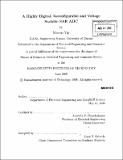A highly digital, reconfigurable and voltage scalable SAR ADC
Author(s)
Yip, Marcus
DownloadFull printable version (16.26Mb)
Other Contributors
Massachusetts Institute of Technology. Dept. of Electrical Engineering and Computer Science.
Advisor
Anantha P. Chandrakasan.
Terms of use
Metadata
Show full item recordAbstract
Micropower sensor networks have a broad range of applications which include military surveillance, environmental monitoring, chemical detection and more recently, medical monitoring systems. Each node of the sensor network requires energy efficient circuits powered off small batteries or harvested energy. In such systems, a single reconfigurable analog-to-digital converter (ADC) is needed to digitize a wide range of signals with varying bandwidth and resolution requirements. This thesis describes the design of an ADC whose power scales exponentially with resolution and linearly with frequency to maximize the system lifetime. The proposed ADC has reconfigurable resolution from 5 to 10-bits and a scalable sample rate from 0 to 1-MS/s. The successive approximation register (SAR) architecture was chosen for its highly digital nature which enables low voltage operation. The supply voltage can be scaled from 1V down to 0.4V such that the ADC maintains a constant energy efficiency across all modes of operation when normalized with respect to sample rate and resolution. A capacitive digital-to -analog converter (DAC) in a split capacitor topology with a sub-DAC is used to minimize the DAC power and area. Top plate switches are used to decouple the MSB capacitors as resolution is scaled to avoid parasitic loading of the DAC. The DAC capacitors are laid out in a common-centroid configuration with edge effects minimized at each resolution mode to improve matching. A fully dynamic latched comparator is used to avoid static bias currents. (cont.) Power gating of the digital logic is used to reduce leakage power at low sample rates. Reconfigurability between single-ended or differential modes enables a power versus performance trade-off. Lastly, programmable sampling duration and internal bootstrapping is used to maintain sampling linearity at low voltages. The ADC has been submitted for fabrication in a low power 65nm digital CMOS process and simulation results are presented.
Description
Thesis (S.M.)--Massachusetts Institute of Technology, Dept. of Electrical Engineering and Computer Science, 2009. Cataloged from PDF version of thesis. Includes bibliographical references (p. 109-112).
Date issued
2009Department
Massachusetts Institute of Technology. Department of Electrical Engineering and Computer SciencePublisher
Massachusetts Institute of Technology
Keywords
Electrical Engineering and Computer Science.